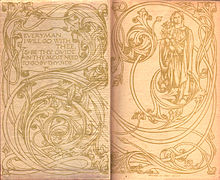Everyman's Library
From Wikipedia, the free encyclopedia
Everyman's Library is a series of reprinted classic literature currently published in hardback by Random House. It was originally an imprint of J. M. Dent (latterly a division of Weidenfeld & Nicolson), who continue to publish Everyman Classics in paperback.
J. M. Dent and Company began to publish the series in 1906. It was conceived in 1905 byLondon publisher Joseph Malaby Dent, whose goal was to create a 1,000 volume library of world literature that was affordable for, and that appealed to, every kind of person, from students to the working classes to the cultural elite. Dent followed the design principles and to a certain extent the style established by William Morris in his Kelmscott Press. This was later replaced in 1935 by Eric Ravilious's designs.[1] Everyman's Library books were pocket-sizedhardcovers that sold initially for what was then the remarkably low price of a shilling apiece. The original U.S. distribution rights were granted to New York City publishers, E. P. Dutton.
History[edit]
The first title published was Boswell's Life of Johnson, published with a quotation on the title page from the works of John Milton: "A good book is the precious life-blood of a master-spirit, embalmed and treasured upon purpose to a life beyond life." In 1910, 500 books had been published under the Everyman trademark, and in 1956 the thousandth volume (Dent's original goal) was published, with Aristotle's Metaphysics selected for the honour. By 1975, Dent's vision had been well surpassed, as Everyman's Library consisted of 994 titles published in 1,239 volumes.[2]
Each book belonged to one of the following genres: Travel, Science, Fiction, Theology & Philosophy, History, Classical, For Young People, Essays, Oratory, Poetry & Drama, Biography, Reference, and Romance. The appropriate genre was printed inside and used to organize lists of the series issued from time to time.[3]
After ceasing publication of new titles in the 1970s, the hardback rights to Everyman's Library were sold to the newly formed David Campbell Publishers in 1991 and relaunched with the support of the Random House Group in the United Kingdom and through Alfred A. Knopf (which had been acquired by Random House in 1960)[4] in the United States—a move which was praised by many notable authors. Control of Everyman's Library passed to US-based Random House in 2002, who continue to publish it under the Knopf Publishers imprint there and (albeit without changes) as Random House UK elsewhere.[5] The current membership of the Honorary Editorial Committee includes Harold Bloom, Henry Louis Gates, Jr., Toni Morrison, Cynthia Ozick and Simon Schama.[6]
J. M. Dent & Sons was acquired by Weidenfeld & Nicolson in 1988, itself acquired by the Orion Publishing Group in 1991, now both part of Hachette Livre (UK). Not to be confused with Everyman's Library, Orion continues to publish Everyman Classics in paperback under the J. M. Dent imprint in the UK and through Charles E. Tuttle Co. in the US.[7]
The name of the publication series was suggested by poet and editor Ernest Rhys, who was named head editor of the series initially, and asked to find a suitable name to encompass Dent's goal. Rhys tried and discarded many ideas before recalling a quotation from the medieval play Everyman in which the character of Knowledge says to Everyman:
- Everyman, I will go with thee
- and be thy guide,
- In thy most need to go
- by thy side.
This quotation appears on the title page of all Everyman's Library volumes.
Everyman's Encyclopedia[edit]
Main article: Everyman's Encyclopaedia
A notable addition to the library was a multi-volume encyclopedia which was added to the range in 1913. Individual volumes could be purchased separately, enabling the set to be budgeted over time. The fifth edition was published in 1967, by which time it consisted of twelve volumes, containing 7763 pages.
The page size was 9 by 5 inches (23 by 13 cm), but as the printing was 8 point, a large amount of information was contained in each volume. As a volume only weighed about 1¼ kg (2¾ lb) it was considered a better size for use by children.
See also[edit]
- Library of America
- Modern Library
- Oxford World's Classics
- Penguin classics
- George Routledge
- Albatross Books
- Tauchnitz publishers
References[edit]
- ^ Steinberg, Sigfrid Henry (1961) Five Hundred Years of Printing; 2nd ed. Harmondsworth: Penguin Books; pp. 356-60
- ^ About Knopf Doubleday Publishing Group Knopf Doubleday Publishing Group (retrieved 10 May 2009)
- ^ Atlas of Ancient & Classical Geography. London: Dent, 1907; prelims.
- ^ About Us Random House (retrieved 10 May 2009)
- ^ Knopf snaps up Everyman's Library Bookseller, 15 November 2002
- ^ About Everyman's Everyman's Library (retrieved 10 May 2009)
- ^ About Orion Orion Publishing Group (retrieved 10 May 2009)
External links[edit]
- Everyman's Library
- Index of Everyman's Library books and authors
- Collecting Everyman's Library (1906-78)
- A Complete Serial List of Everyman's Library titles (new series, 1991- )
- McVety, Margaret A., Dictionary catalogue of the first 505 volumes of Everyman's Library. London, J.M. Dent; New York, E.P. Dutton. 1911. via Internet Archive. Annotated catalog of first 505 titles.
- Buying and Selling Everyman's Library: A Primer
- Complete Everyman's Library Catalog (1906 - 1982), author list, dust jacket images, and other useful Everyman's Library information


沒有留言:
張貼留言
注意:只有此網誌的成員可以留言。